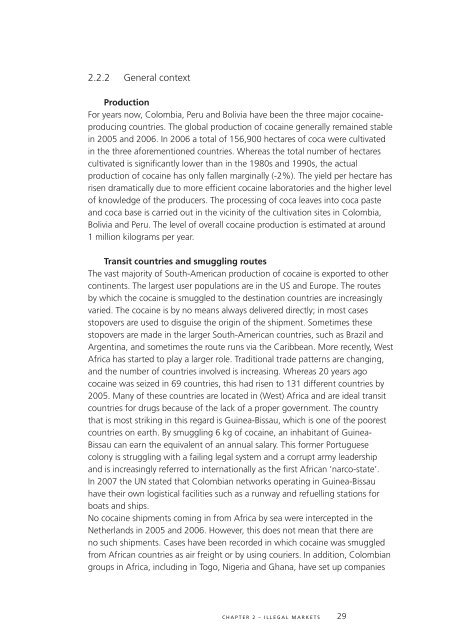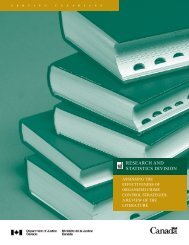National Threat Assessment 2008. Organised Crime - Politie
National Threat Assessment 2008. Organised Crime - Politie
National Threat Assessment 2008. Organised Crime - Politie
You also want an ePaper? Increase the reach of your titles
YUMPU automatically turns print PDFs into web optimized ePapers that Google loves.
2.2.2 General context<br />
Production<br />
For years now, Colombia, Peru and Bolivia have been the three major cocaineproducing<br />
countries. The global production of cocaine generally remained stable<br />
in 2005 and 2006. In 2006 a total of 156,900 hectares of coca were cultivated<br />
in the three aforementioned countries. Whereas the total number of hectares<br />
cultivated is significantly lower than in the 1980s and 1990s, the actual<br />
production of cocaine has only fallen marginally (-2%). The yield per hectare has<br />
risen dramatically due to more efficient cocaine laboratories and the higher level<br />
of knowledge of the producers. The processing of coca leaves into coca paste<br />
and coca base is carried out in the vicinity of the cultivation sites in Colombia,<br />
Bolivia and Peru. The level of overall cocaine production is estimated at around<br />
1 million kilograms per year.<br />
Transit countries and smuggling routes<br />
The vast majority of South-American production of cocaine is exported to other<br />
continents. The largest user populations are in the US and Europe. The routes<br />
by which the cocaine is smuggled to the destination countries are increasingly<br />
varied. The cocaine is by no means always delivered directly; in most cases<br />
stopovers are used to disguise the origin of the shipment. Sometimes these<br />
stopovers are made in the larger South-American countries, such as Brazil and<br />
Argentina, and sometimes the route runs via the Caribbean. More recently, West<br />
Africa has started to play a larger role. Traditional trade patterns are changing,<br />
and the number of countries involved is increasing. Whereas 20 years ago<br />
cocaine was seized in 69 countries, this had risen to 131 different countries by<br />
2005. Many of these countries are located in (West) Africa and are ideal transit<br />
countries for drugs because of the lack of a proper government. The country<br />
that is most striking in this regard is Guinea-Bissau, which is one of the poorest<br />
countries on earth. By smuggling 6 kg of cocaine, an inhabitant of Guinea-<br />
Bissau can earn the equivalent of an annual salary. This former Portuguese<br />
colony is struggling with a failing legal system and a corrupt army leadership<br />
and is increasingly referred to internationally as the first African ‘narco-state’.<br />
In 2007 the UN stated that Colombian networks operating in Guinea-Bissau<br />
have their own logistical facilities such as a runway and refuelling stations for<br />
boats and ships.<br />
No cocaine shipments coming in from Africa by sea were intercepted in the<br />
Netherlands in 2005 and 2006. However, this does not mean that there are<br />
no such shipments. Cases have been recorded in which cocaine was smuggled<br />
from African countries as air freight or by using couriers. In addition, Colombian<br />
groups in Africa, including in Togo, Nigeria and Ghana, have set up companies<br />
chapter 2 – Illegal markets<br />
29








